- Blog
- Psychographics Examples in Marketing to Help You Better Understand Your Target Audience
Psychographics Examples in Marketing to Help You Better Understand Your Target Audience
-
Nikolett Lorincz
- Marketing
- 6 min read
Table of Contents
Most companies understand that the more they know about their customers and consumer behavior, the more effective their marketing campaigns will be.
That’s why many companies use demographic segmentation to divide their target market into groups based on gender, household income, social status, and location.
But when you go beyond simple geographic or demographic segmentation and start to explore the nuances of your customers’ personality traits, you can achieve much better market segmentation.
In this article, we’ll go over the basics of how to use psychographic segmentation, and we’ll check out 7 real-world examples of psychographic segmentation that top ecommerce brands used to create precisely targeted, tailored marketing campaigns.
Let’s jump in!
What does “psychographics” mean?
At the most basic level, psychographics is the attempt to describe complicated psychological characteristics in simple terms that can be useful for everything from marketing strategy to government policymaking.
Wikipedia defines psychographics as “a qualitative methodology used to describe traits of humans on psychological attributes.”
Researchers and marketers often use a combination of qualitative methods (e.g., a customer survey plus behavioral data) to split people into groups based on their “personality, values, opinions, attitudes, interests, and lifestyles.”
What’s the difference between demographics and psychographics?
Today, most market research is done using demographics and psychographics. Although they’re linked, many people often confuse them. Simply put, demographics explain who your target customer is, while psychographics explain why they buy.
Another way of understanding the difference between the two is that demographic data is always directly observable. Demographic data types like age, occupation, and level of education are easy to see when you have access to the right data.
When it comes to psychographics, you can’t see customers’ personalities directly—it’s a hidden variable.
Here are some of the things psychographic segmentation takes into account:
- Lifestyle: What’s the person’s day-to-day life like? Who do they associate with? Where do they spend their time?
- Personality: What kind of personality traits do they display? Are they introverts or extroverts?
- Values: What kind of moral compass do they have? What are some of the pillars they will always stand by?
- Activities and interests: What occupies their time? What are their favorite hobbies? What do their media consumption habits look like?
- Opinions and beliefs: These two can be broken down into separate psychographic categories, but we’ve grouped them together because there’s a strong overlap. Ask yourself things like: What are their religious beliefs? Political views? Worldviews?
See how deep psychographic segmentation can get?
Let’s look at an example of a well-rounded buyer persona for a natural supplement company.
Demographic profile:
- Male
- Aged 35-45
- Single
- Dealing with weight gain and binge eating
- Works a very demanding wealth management job
- Personal income of 150K+
Psychographic profile:
- Wants a healthier lifestyle but doesn’t have the time to cook healthy meals at home
- Spends a lot of time watching natural supplement reviews on YouTube
- Concerned with his health and appearance
- Goes to the gym twice a week but feels it isn’t enough to balance his random weight gain
You can see how much clearer the customer persona becomes when both the demographic and psychographic profiles are used.
When it comes to marketing and sales, the more granular the information, the easier it will be to attract your ideal customer and increase your conversion rate.
Why is psychographic segmentation important?
Psychographics help you create a more actionable buyer persona.
As humans, we’re dynamic and have plenty of layers. It’s not enough to simply list a set of “typical” traits and call it a day.
When you create a buyer persona, you have to account for how different people within your target audience think and feel, as well as what motivates them to act. This isn’t just some Machiavellian way to “hack the human psyche.” Rather, psychographic audience segmentation is about relating to your customers as people.
Psychographics can help you develop more empathy toward your ideal customer. And by putting yourself in someone else’s shoes, you’ll build a connection that goes way beyond making a sale or achieving quarterly goals.
You can use psychographics to lay the foundation for a brand that truly cares for its customer and in turn, the customer will pay you back with loyalty and referrals.
How to gather psychographic data?
Collecting psychographic data is essential for understanding your audience on a deeper level. Here are some effective methods to collect this data:
1. Customer interviews
Talking to your customers directly is a powerful way to collect psychographic data. Conduct customer interviews to gain candid insights.
Create a relaxed atmosphere to encourage open and honest conversations. This helps in understanding personal motivations, challenges, and preferences.
2. Surveys
Deploy surveys to a broader audience segment to validate findings from interviews. Ensure your questions are designed to reveal psychographic traits such as interests, values, and opinions.
You can use popup surveys like the ones below:
3. Focus groups
Engage in small focus groups for dynamic discussions. This qualitative approach uncovers hidden psychographic patterns and provides a deeper understanding of participants’ mindsets and behaviors.
Facilitating structured discussions helps in gaining insights into motivations, beliefs, and preferences.
4. Brainstorm sessions
Involve internal stakeholders to uncover additional insights. These sessions can provide different perspectives on the data collected and help in identifying key psychographic factors and trends.
5. Market research firms
Consider working with market research firms that use intensive scientific data collection techniques. They gather data from representative samples and analyze it using advanced statistical methods. This approach can provide a comprehensive psychographic profile.
6. Social media analysis
Social media platforms are a goldmine for psychographic data. Analyze the content users engage with, the pages they follow, and the groups they join.
This data helps construct detailed psychographic profiles, allowing for more personalized and targeted marketing strategies.
How to use psychographic research?
Once you’ve gathered psychographic data, the next step is to integrate these insights into your marketing strategy.
Here’s how to do it effectively:
- Review with experts: Collaborate with internal experts to align the psychographic data with your product features. Their expertise helps translate psychographic insights into actionable strategies.
- Identify key selling points: Focus on the selling points that resonate most with your target audience’s psychographic profiles. Highlight aspects that align with their values, interests, and lifestyle choices.
- Train sales teams: Ensure your sales team understands the psychographic data. Training them to align their pitch with customer values enhances their ability to connect with target customers.
- Optimize messaging: Tailor your marketing messages to leverage the psychographic data. Use language and themes that resonate with your audience’s psychological triggers, ensuring your marketing campaigns are impactful and engaging.
The 5 insights psychographic information provides
The Buyer Persona Institute has a model called the 5 Rings of Buyer Insight that demonstrates the characteristics that guide purchase decisions.
You can use these characteristics to create a psychographic market segmentation strategy that tailors your ad campaigns and other marketing campaigns to specific profiles of users.
For each characteristic, we’ll also share some psychographic segmentation examples to show how your marketing messages can respond to the psychographic profiles of different groups of customers.
Let’s dive in!
1. Priority initiatives
No matter what type of product or service you provide, some potential customers will be more receptive to your branding, product design, and unique selling point than others. You should try to find psychographic data that shows what psychological traits lead a customer to choose your solution or product over others.
For example, is your branding and marketing more likely to appeal to risk takers or people who like to play it safe?
Red Bull’s marketing strategies have always revolved around finding ways to grab the attention of their young, enthusiastic, risk-taking audience.
A company like FedEx, on the other hand, has always pursued a business-oriented target market that appreciates its quick, reliable delivery.
2. Success factors
When customers are making buying decisions, what features of your product type do they consider to be the most important? What results do they expect?
Let’s say a university student is looking for a new computer. You might think that portability, speed, and processing power would matter the most. And perhaps that would be true for a computer engineering student who needs a laptop capable of running lots of complicated code. But there might be another psychographic segment that cares more about the status that comes with a MacBook than actual specs.
This means your marketing team should have different approaches to these two different types of potential customers.
3. Perceived barriers
Another insight we can gain from psychographic segmentation is the top concerns that might prevent a buyer from purchasing your product. Is cost an obstacle? Are people worried about buying your product online since they can’t touch or feel it?
You can use your marketing efforts to proactively address the perceived barriers standing in the way of your customers buying your product. But first, you have to know what those barriers are.
4. Buyer’s journey
Website visitors will respond to the same message very differently depending on what stage of the buying journey they are at.
For example, a customer who is just about to make a purchase will be happy to see a popup offering a 10% discount, but someone who is just learning about your brand and products won’t be ready to see that message yet.
5. Decision criteria
When it comes to a comparison between your products and your competitors, what are the most important differences? What features might tempt your existing clients to switch sides?
Once again, you should consider the possibility that psychographic segmentation might reveal that different groups of customers perceive different features to be the most crucial for their buying decisions.
7 real-life psychographic examples that influenced purchasing behavior
Ready to cut through the noise and make your brand stand out? Here are some brands that used psychographic targeting to build customer empathy and drive more sales.
Read on and get inspired by these examples!
1. Ted Baker’s Twitter ad campaign
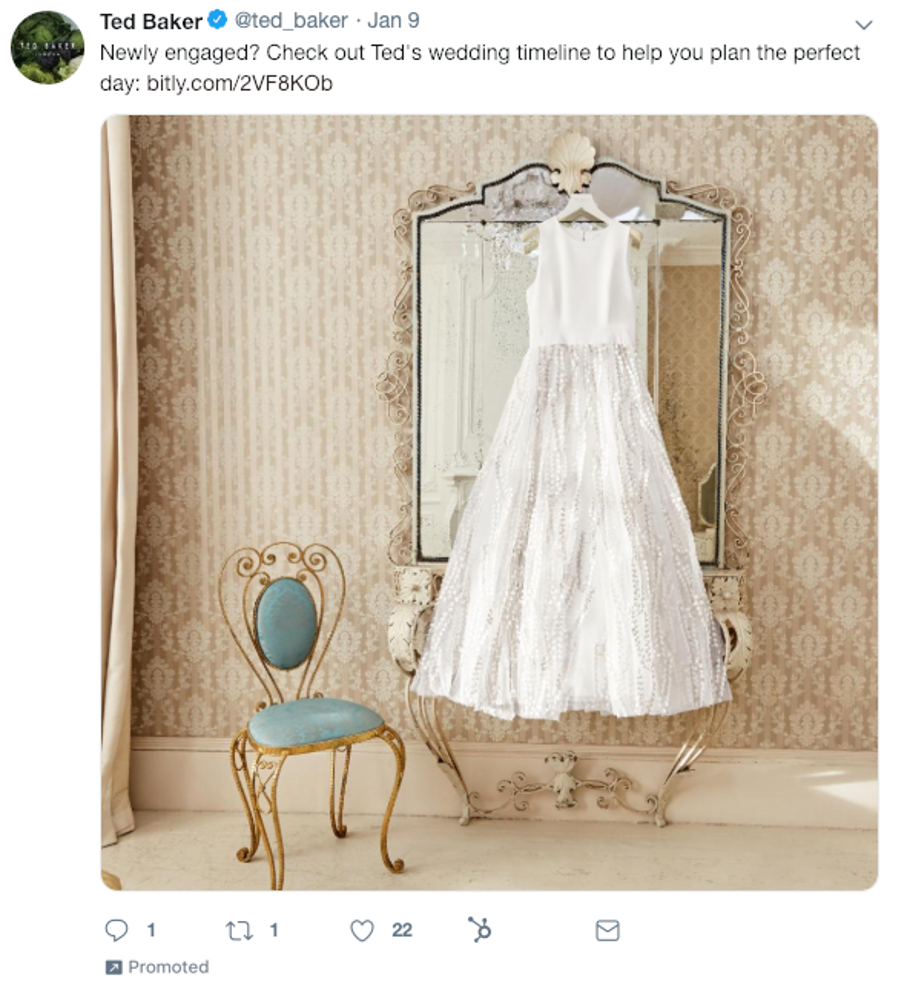
Why does it make the powerful psychographics examples list?
When you engage with people on social media, you have the opportunity to create a bond with them. This ad targeted Twitter users based on their marital status: newlyweds, engaged people, or married couples.
The ad uses emotional copy with powerful graphics to make the message relevant to a well-defined target audience.
Think about how people will use your products: can they be used to celebrate special occasions like in the example above? Perhaps you can run campaigns around traditional gift-giving holidays like Christmas and Mother’s Day.
2. CupShe’s Facebook ad campaign
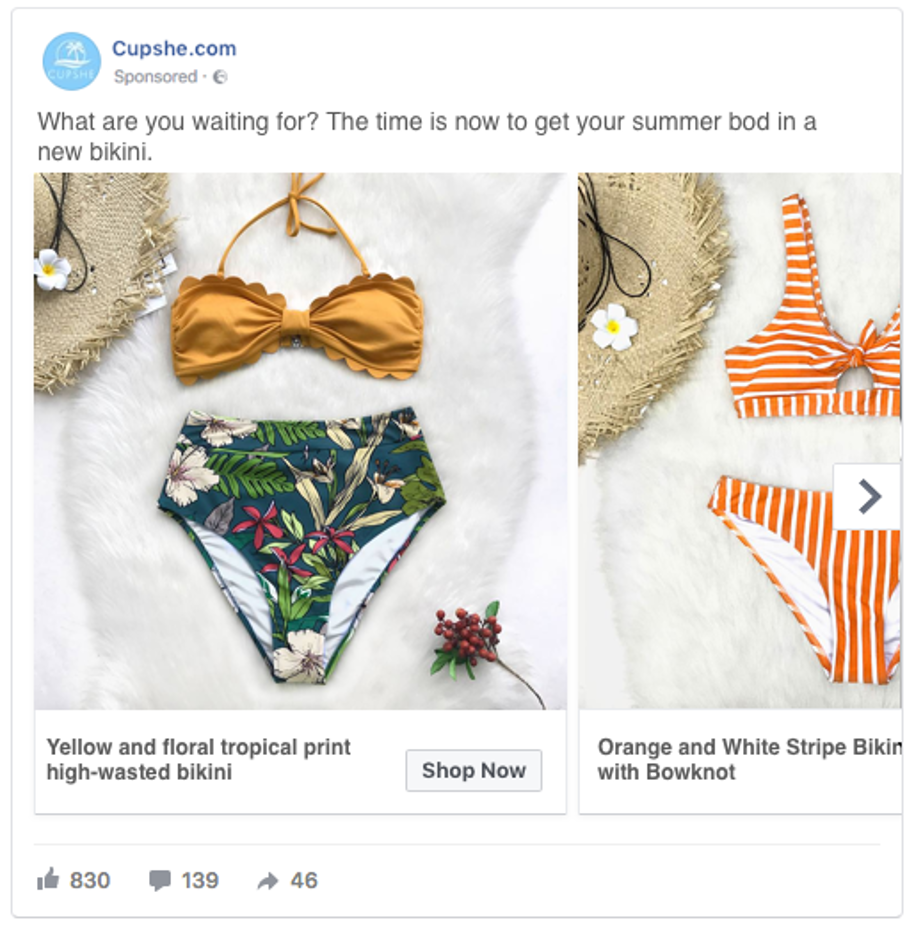
Why does it make the powerful psychographics examples list?
It’s a non-intrusive retargeting campaign that resonates with the target audience. The copy and CTA are clear and timely. CupShe’s market researchers tapped into what they knew their customers were thinking about at the beginning of summer!
A note of caution: be careful about retargeting too aggressively, as it can sometimes make people feel like you’re stalking them online.
3. Asics’s intelligent product listing
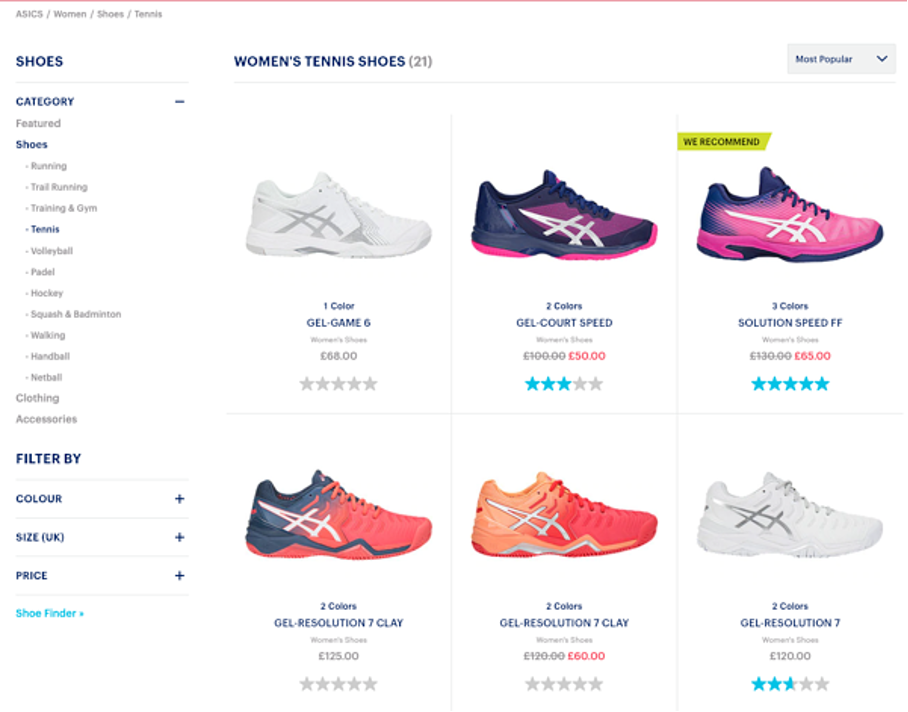
Why does it make the powerful psychographics examples list?
Product listing pages are often underrated for their ability to boost conversions. Asics leverages persuasion techniques here with the “We Recommend” badge, providing an extra nudge to customers who want expert approval or advice before purchasing.
What persuasive techniques could you use with your products? Do you have plenty of positive reviews? Showcase them! Are you running a limited-time sale? Infuse some scarcity in your copy!
4. Dollar Shave Club’s Facebook ad
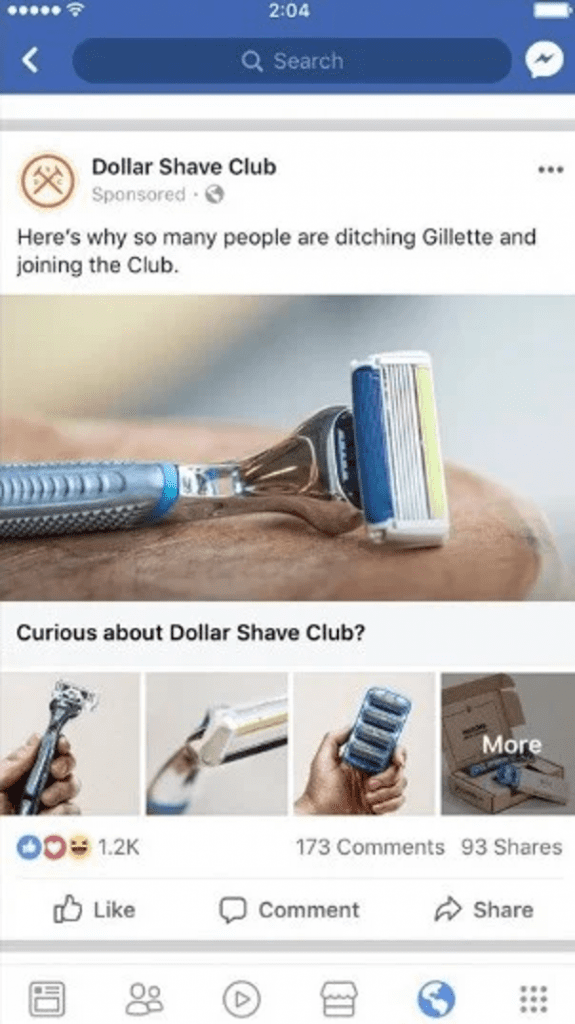
Why does it make the powerful psychographics examples list?
Dollar Shave Club went bold in its attempt to win more of the men’s grooming market from competitors. This ad’s copy says that customers are “ditching” big names like Gillette, piquing their target audience’s curiosity.
Dollar Shave Club leveraged its data points and understood that its audience would respond well to this kind of message. If you know which other brands your target audience uses or trusts, being explicit about how you outperform them can serve as a powerful marketing tool.
5. Uber and the endowment effect
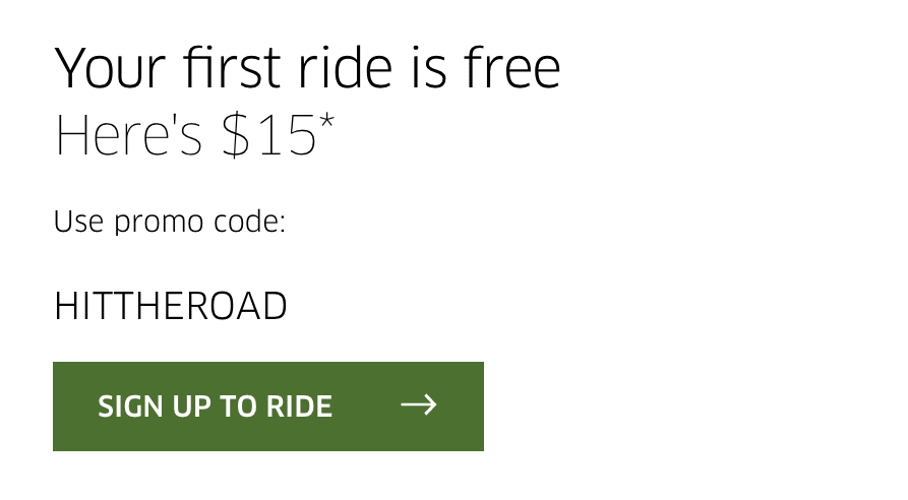
Why does it make the powerful psychographics examples list?
The endowment effect is an emotional bias that causes individuals to (often irrationally) value an owned object higher than its market value.
In the example above, Uber creates a sense of ownership (“your” first ride—it’s yours) right off the bat. It doesn’t matter that you have to sign up in order to get the $15. When you see this coupon, you give it more value than it actually deserves (which is precisely $15). This giveaway idea is simple but extremely effective.
6. Crate & Barrel and the goal-gradient effect

Why does it make the powerful psychographics examples list?
Cart abandonment is a huge problem in ecommerce. If you’re an ecommerce business owner, many causes of cart abandonment are out of your control. What you can do is reduce the layers of friction between the moment a customer places products in their cart and when they click the checkout button.
Crate & Barrel does this well by employing the goal-gradient effect: in simple terms, the effort someone is willing to exert toward a goal increases the closer they get to that goal. When it’s checkout time, try implementing a short 2 or 3-step visual that shows customers they’re almost there. They’ll be more likely to finish when they see how simple and painless checkout is!
7. Kate Spade and email marketing
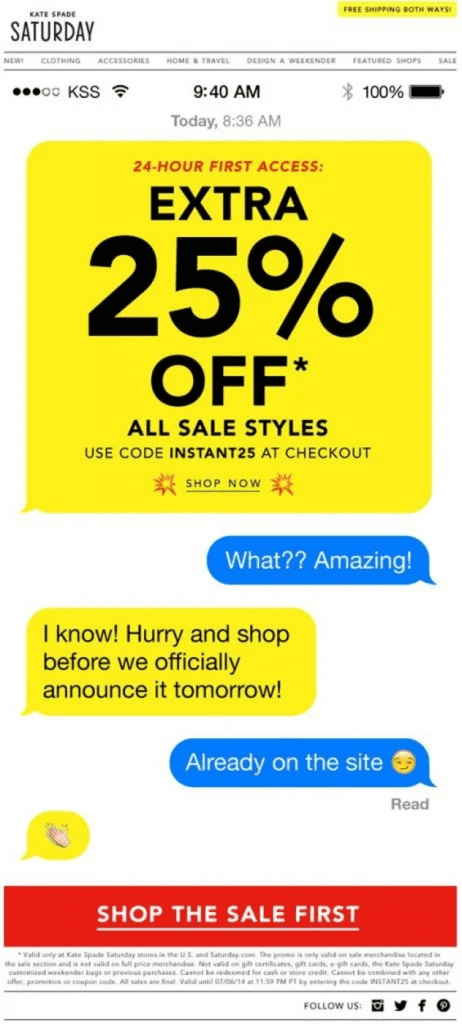
Why does it make the powerful psychographics examples list?
When you think about the number of newsletters the average person receives, you can see why it’s so important to stand out.
When was the last time you were “wowed” by an email newsletter? That’s what makes this Kate Spade email special. It’s a coupon email, but the style mimics a text message to grab your attention. Just like a good conversation with a friend via text would keep you engaged, this email borrows the bright text bubbles to format the coupon email.
Plus, the copy includes just the right amount of scarcity to drive the desired behavior.
Wrapping up
In this article, we learned about why incorporating psychographics into your marketing and sales strategy is important. We also looked at the difference between demographics and psychographics.
By now, you should have a solid understanding of psychographics and how they work to create a well-rounded, granular buyer persona.
Hopefully, you found plenty of inspiration for the various stages of the marketing funnel and different communication channels in our 7 powerful psychographics examples!
Migration has never been easier
We made switching a no-brainer with our free, white-glove onboarding service so you can get started in the blink of an eye.

What should you do next?
Thanks for reading till the end. Here are 4 ways we can help you grow your business:
Boost conversions with proven use cases
Explore our Use Case Library, filled with actionable personalization examples and step-by-step guides to unlock your website's full potential. Check out Use Case Library
Create a free OptiMonk account
Create a free OptiMonk account and easily get started with popups and conversion rate optimization. Get OptiMonk free
Get advice from a CRO expert
Schedule a personalized discovery call with one of our experts to explore how OptiMonk can help you grow your business. Book a demo
Join our weekly newsletter
Real CRO insights & marketing tips. No fluff. Straight to your inbox. Subscribe now
Nikolett Lorincz
- Posted in
- Marketing
Partner with us
- © OptiMonk. All rights reserved!
- Terms of Use
- Privacy Policy
- Cookie Policy
Product updates: January Release 2025








